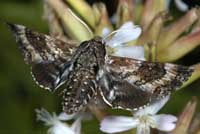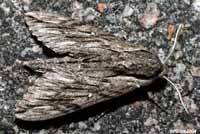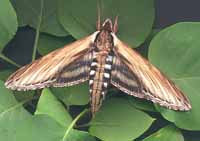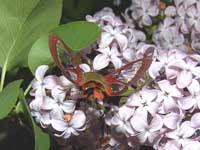Sphingini tribe:
 |
Agrius cingulata
stray,
Pink-spotted Hawkmoth
stray
This moth is a very strong flier, but would only make its way to
New Brunswick as a rare stray.
|
 |
Ceratomia amyntor
abundant,
the Elm Sphinx or Four-horned Sphinx
The upperside of the forewing is brown with dark brown and white markings including a white costal area near the wing base, dark streaks along the veins, and a white spot in the cell.
|
Ceratomia amyntor larva, Norton, September 7, 2009, Gordon Snyder.
 |
The upperside of the forewing is pale brownish gray with wavy black
and white lines and a black-outlined white cell spot. The upperside
of the hindwing is gray with diffuse darker bands.
|
 |
Dolba hyloeus
present, the Pawpaw Sphinx
The upperside of the forewing is dark brown with a dusting of white
scales. Some moths have patches of reddish or yellowish brown on the
wings.
|
 |
If you have pines, you probably have this species. It flies on P.E.I.
|
 |
Manduca quinquemaculatus
abundant,
the Five-spotted Hawkmoth
The moth abdomen usually has five but sometimes six pairs of yellow
bands. The upperside of the forewing is blurry brown and gray.
I suspect if you grow tomatoes, you are likely to encounter it.
|
Manduca quinquemaculatus larva, Sandy Island, Oct. 1, 2006,
courtesy of Cameron Dick, via Tara and Jerome Dick.
 | The upperside of the forewing is gray with indistinct black and
white markings. There is a series of black dashes
from the base to the tip, and a small white cell spot.
|

|
Sphinx canadensis
present,
Sphinx canadensis, the Canadian Sphinx, is not common, and is not
often reported anywhere,
but it might be present in Ontario County as it is reported from
southern Ontario, Canada.
Larval hosts are white ash (Fraxinus americana) and blueberry
(Vaccinium).
|
 |
Sphinx chersis
abundant, the Northern Ash Sphinx or
Great Ash SphinxThis species is present and is probably common.
Larval hosts are ash, lilac, privet, cherry, and quaking
aspen.
|
Sphinx chersis larva, Ossekeag, August 15, 2005, Gordie Snyder.
 |
This species is officially reported in Ontario. We have them
on P.E.I., but I do not see them nearly as frequently
as I see the other Sphingidae.
|
 |
Sphinx gordius
probably poecila, the
Apple Sphinx
The upperside of the forewing ranges from brown with black borders
through brownish gray with paler borders to pale gray with no
borders. probably poecila in New Brunswick |
 |
The lower forewings are predominantly brownish-yellow with a fairly
wide dark bar along the inner margin. At rest the wings hug the body,
giving the moth a long slender look.
|
 |
Sphinx luscitiosa
present,
the Canadian Sphinx or
Clemen's Sphinx
This one is reported from Ontario, but it is generally not common.
|
Sphinx luscitiosa, southwest of St. John, Charlotte County, July 16, 2002, Bill Oehlke
Sphinx luscitiosa, New Jersey, Northumberland County, June 27, 2005, Robin McLeod
Sphinx luscitiosa, Edmundston, Madawaska County, Martin Turgeon
 |
Sphinx poecila
abundant, the Poecila Sphinx
If you have blueberries in the woods, then you might have the
Poecila Sphinx.
They are pretty common here on Prince Edward Island.
|
Smerinthini Tribe:
 |
The adults are also highly variable; sometimes wings of an individual
may be all one color or may have several colors, ranging from pale to
dark brown, and may have a white or pink tinge.
See the file for the female; she is different.
|
 |
Pachysphinx modesta
common,
the Modest Sphinx or Poplar Sphinx
This moth is recorded regularly in Ontario. Its larvae are
fond of poplars and
willows.
They are common on Prince Edward Island.
|
 |
Named for the dull grey-blue spot (minus dark pupil) in the hindwing,
this moth has a wide distribution and is common in Ontario.
I regularly see them on Prince Edward Island, and they are reported
as far south as Florida. |
 |
Paonias myopscommon, the Small-eyed Sphinx
Named for the small eye-spot in the hindwing, this moth has a wide
distribution and is probably common in Ontario.
I regularly see them on Prince Edward Island, and they are reported
as far south as Florida.
|
 |
Smerinthus cerisyi
common,
the Cerisyi's Sphinx
Smerinthus cerisyi is found in the southern regions of all Canadian
provinces and in northern border states. The one-eyed sphinx is also
found along the U.S. west coast, eastward to the Rockies. At my home
in Montague, P.E.I., Canada, they are quite common.
|
 |
This moth is widely distributed and fairly common.
Along the East Coast, it flies from P.E.I. to Florida. I suspect it
is present. |
Macroglossinae subfamily
Dilophonotini tribe:
See Hemaris comparison to help distinguish
the next four species.
 |
Hemaris thysbe
common, the Hummingbird Clearwing
It is not difficult to see why many gardeners would mistake an
Hemaris thysbe moth for a small hummingbird as it hovers,
sipping nectar from flowers through a long feeding tube.
|
Hemaris thysbe adult, Quispamsis, August 7, 2005, courtesy of Bev England.
Hemaris thysbe adult, Geary, Sunbury County, August 1, 2010, courtesy of Helen Mňrag McKinnon.
 |
Hemaris aethra
common.
Note large orangey-brown forewing apical patch. In very similar H. diffinis patch is smaller.
On average H. aethra, compared to H. diffinis, tends to be slightly larger, with more orangey-yellow tone,
less tapering (top to bottom) of dark thorax/abdominal region; more red nr hw anal angle.
|
 |
Hemaris diffinis
common, the
Snowberry Clearwing or Bumblebee Moth
Adults mimic bumblebees and are quite variable. The wings are
basically clear, with dark brown to brownish-orange veins, bases
and edges. The thorax is golden-brown to dark greenish-brown with
1-2 yellow segments on the abdomen.
|
 |
Hemaris gracilis
present, the
Slender Clearwing or Graceful Clearwing
This day-flying moth is less common.
|
Hemaris gracilis, Bathurst, July 3, 2018, Krista Melville
Macroglossini tribe:
 |
This day flier is widely distributed. If you have Virginia Creeper,
you probably have the Nessus Sphinx. It is officially reported
from Ontario.
Two bright, distinct, narrow yellow
bands are often visible on the abdomen.
|
Amphion floridensis necturing on Dame's Rocket, English Settlement Road - near Taymouth, June 19, Julie Singleton.
 |
They are common in New Jersey and common
here on Prince Edward Island.
You will often see this species listed as Darapsa pholus,
especially in older literature.
It is confirmed for New Brunswick.
|
 |
Hyles gallii
present, the Bedstraw Hawk Moth
or Gallium Sphinx
This species is reported in Ontario.
Some years I see them on P.E.I., some years, I do not.
|
Hyles gallii larva, Coverdale (five miles from Moncton Bridge), August 6, 2006, Anne Marsch.
 |
This day flier is officially reported from Ontario, but it
maynot be common. Look for them in meadows near coniferous forests.
|
|


